The life of Marty O’Keefe and Querrin Bird Hide.
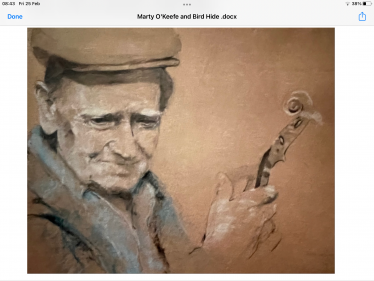
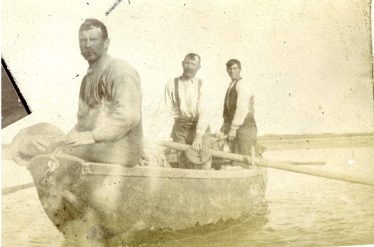
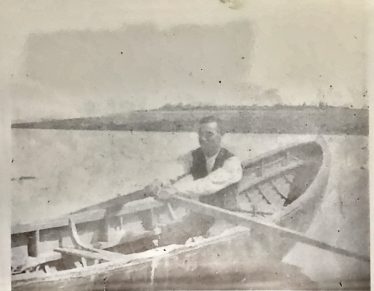
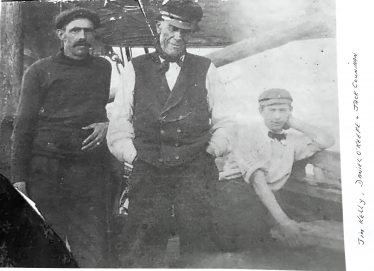
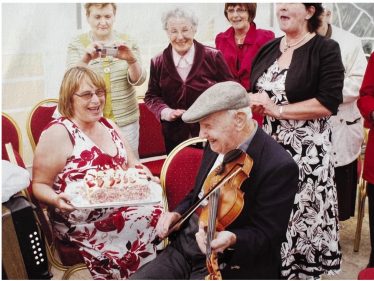
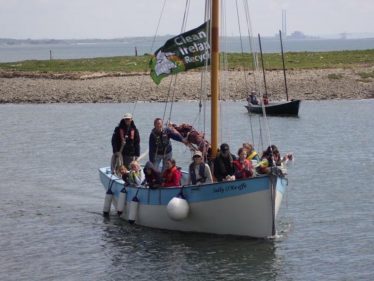
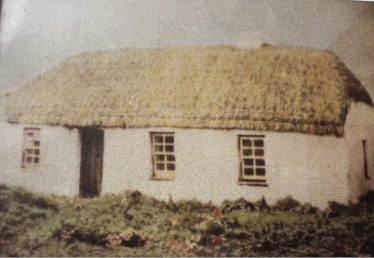
Marty O’Keefe and Querrin Bird Hide.
Querrin Pier Community Development Group purchased a site of .2 of a hectare in 2022 along the shore road at Querrin between the Pier and the graveyard. On this site there stood a thatched cottage with a small plot of land. The property belonged to the O’Keefe family until the late 1940s. The house is now long gone but remnants of it could be seen until the 1960s. Ned Griffen, who was still in contact with the family who had all emigrated to America, wrote to the O’Keefe family in the United States telling them of the project and before long the family had forwarded a fund to buy back the old site for the group.
Marty O’Keefe. 1st November 1912 – 5th November 2015.
Martin O’Keefe was born on the Feast of All Saints, 1 November 1912, in this house along Querrin shore. In the ancient Irish calendar 1 November was the Feast of Samhain, the Celtic New Year, when the curtain between the spirit world and the material world was thinnest, when the spirits of those who went before could walk among the living. In the same way Martin served as the tradition walking among us; the embodiment of the musical tradition bearers long gone before.
“Marty,” as he was known to his friends and colleagues, was the third of four children born to James O’Keefe (1878-27 August 1943) and his wife Katie (1882-23 January 1930). All three of his siblings preceded him to the United States. Both his brother John J. “Jack” O’Keefe (12 May 1906-23 January 1994, himself a renowned Rochester traditional musician) and sister Kathleen O’Keefe (later Mrs. Robert Emmett Downs, 10 June 1909-25 February 1993) were already in Rochester by 1930. His younger sister Maureen O’Keefe (called “Mary” by the family, later Mrs. John Francis Egan, 1 January 1916-22 February 1950) arrived in the United States in 1931, settling in Westchester County, New York (north of New York City).
Marty’s mother was a housewife, while James began his working life as a fisherman, later working as a riverboat pilot (like James’ father Dennis before him), guiding commercial ships from the Atlantic up the Shannon into Limerick town.
Marty left Querrin school at 14 to fish commercially and continue in the family trade of life on the water, fishing in the Shannon River in a curragh (the traditional Irish hide-covered boats), plying for herring, mackerel, pollack, salmon and lobster.
Sometime between 1937 and 1940 (when Marty was in his late 20s) he moved to England to find a better job. In the years before the war, he divided his time between levelling cement for a building contractor and returning to Ireland each spring to fish. When “the Phony War” that followed the invasion of Poland and the beginning of World War II ended in the spring of 1940 and fighting began in earnest, Marty was unable to leave Clare, and he resumed full-time the life of a curragh fisherman. Following the death of his father in 1943 in a fishing boat accident and the end of the war in 1945, Marty sought to come to America in search of economic opportunity. Relatives, including his brother Jack and sisters Kathleen and Mary, had already immigrated to America.
He arrived in New York in 1947, by way of Newfoundland, Canada, on one of the first trans-Atlantic propeller planes out of Shannon Airport. His first stop was the County Line Cabin (Baldwin Place, New York), a bar and restaurant owned by his sister Mary that straddled Westchester and Putnam Counties. Mary set him up in an apartment attached to the restaurant, and Marty earned money waiting tables and serving drinks. He still hoped to earn enough to buy a boat larger than a curragh and return home.
Life had other plans. Also working at the County Line Cabin was Mary Theresa Curley (2 May 1931-27 May 1998), a young waitress from Tuam, Co. Galway who was 19 years younger than he. Theresa did not care for drink or fishing and had no intention of returning to Ireland. Marty fell in love with Theresa, giving up his idea of returning to the life he knew. Following the death of his sister Mary (O’Keefe) Egan (22 February 1950) and that of her husband John Francis Egan (22 February 1898-15 February 1949) the previous year, the restaurant was sold and Marty’s employment prospects dried up.
Marty and Theresa then moved to Rochester, New York later in 1950, where each found employment. The couple were married 23 October 1954. In time Marty and Theresa had eight children: John O’Keefe; Martin O’Keefe; Jerry O’Keefe; James O’Keefe; Mary (O’Keefe) Kohlmeier; Kathleen (O’Keefe) Peters; Noreen (O’Keefe) Flanagan; and Colleen (O’Keefe) Barnes.
Among the things he brought to America was his musical talents. As a boy he learned to play his mother’s concertina (an instrument for women in those days) and his brother Jack’s fiddle. Also in the home was a tin whistle, and in time he learned to play the wooden flute as well . He also acquired the traditional art of lilting, singing tunes to nonsense syllables instead of words. Traditionally lilting the melody enabled dancers to perform the steps even when no musicians were present. In some communities lilting also served as a counterpoint to the melody even as other instruments were in play (a common practice in Marty’s youth). Marty used lilting in the latter sense in solo performance. In broader sessions Marty would also lilt to communicate a tune whose title he might not know to other musicians.
Marty did not learn these skills by osmosis. His mother and other musicians in the area around Querrin would teach him tunes and he would return home and practice until he had mastered them. Occasionally he would also pick up tunes from itinerant musicians passing through the area. What made his education that much more remarkable was that he never learned to read musical notation (and it is likely his instructors never did either), and in that era no recording devices (either tape or digital) were commonly available. Regarding Marty’s musical education, friend and fellow musician Joe Dady was quoted as saying, “I remember him telling me about when he was learning the fiddle. He used to ride his bike 10 or 15 miles from his house for a lesson, then have to whistle the tune all the way home to remember it.” Marty was the living embodiment of the Irish oral musical tradition, learning tunes by ear, not by sight.
Over the years in Rochester, O’Keefe tended boilers in schools and worked at an old camera factory. In the evenings he joined other Irish musicians at the Hibernian and Harps clubs. “Where Irish people could meet their own,” Joe Dady said. “Play their songs, sing their tunes.
“ A buddy took me to The Friendship Tavern on Lake Avenue. People like his brother Jack O’Keefe , who’s dead now, and Ted McGrath would be there, and they’d be playing jigs and reels with fiddles and accordions. Marty was always at the centre of it all.
“If he showed up at one of our gigs, we’d get him up there. If Peggy Dolan was playing, he’d get up with her, or any of the other balladeers, because he knew a zillion melodies.”
Pat Dunn studied Mr. O’Keefe for years at Carroll’s. “I was his bartender fairly often,” said Dunn. “I could tell you stories. Most of them could not be printed.
“He had good genes. And then he would show you his genes. I was always amazed at his ability to remember stuff, his recall. Even at 101 he didn’t have any trouble.”
It wasn’t always a lucky charms life. He was 18 when his mother died of heart trouble, and while Irish tradition calls for a period of music-less mourning, he played on for himself, as silently as possible. In 1970, Mr. O’Keefe lost the tips of some of the fingers on his left hand in a lawnmower accident. When he was able to pick up the fiddle again, the effect was what might be expected. “There was one higher note he couldn’t reach sometimes,” Ryan said. Yet Mr. O’Keefe found ways to get it done. “When he played the concertina, he would put duct tape on the end of his fingers,” Dady said. Mr. O’Keefe also fell off the roof of his house in 1988 and broke his neck in a 1991 car accident. Theresa his wife died of cancer in 1998.
But the seanchaí could not be silenced. He finished recording his first CD, Dawn in the Hills of Ireland, three days after he turned 89.
Having been reared and tutored in southwest Clare, Marty’s playing was noted for preserving the West Clare style of fiddle playing, including finger rolls, bending notes, and intentional shading of both flats and sharps. In concertina playing, West Clare playing is highly rhythmical and melodically simple, with single- row fingering techniques and repertoire including reels, jigs (including slip jigs and triple jigs), hornpipes, marches, polkas, slides, set pieces and flings. Marty’s playing on the instrument exhibited these styles.
It wasn’t until 30 years after he’d arrived in America that Marty finally returned to Ireland, in 1977, the first of many visits. In his nearly annual trips back to Ireland, he has performed at the Willie Clancy Summer School (Scoil Samhraidh Willie Clancy) and been interviewed on Clare FM radio. He is featured in a museum in Miltown Malbay honoring local musicians, and in 1998 he was part of the inaugural inductee class of the North East Region Hall of Fame of the North American Province of Comhaltas Ceoltóirí Éireann. He also served twice as Grand Marshall of the St. Patrick’s Day Parade in Rochester, in 1985 and again in 2011.To demonstrate the love and respect in which he was held by the community, two major birthday celebrations were held for him, one for his 95th birthday (2007) and one for his 100th birthday (2012).
During his last few years, however, health issues had slowed him down, making attendance at local sessions more difficult. To include Marty, musicians had to come to his home to play, but even that became more difficult as time passed. While his musical spirit was willing, his body continued to weaken. Marty O’Keefe died four days following his 103rd birthday, 5 November 2015 in Rochester. His wake and funeral were attended by literally hundreds of family, friends and fellow musicians who loved and honoured him for his contributions to Irish music in Rochester.
It was at the funeral that another aspect of Marty’s life was revealed that was unknown to all but his family and closest friends. His deep and personal devotion to Christ and the Virgin Mary, and to Saints Theresa and Padre Pio. He attended daily Mass when his health permitted, and family life ended each day with a daily rosary. He strove to live life as God would have him live it. Appropriate for one born on the Feast of All Saints, those he leaves behind have no doubt that upon approaching the Pearly Gates Martin will hear the Divine Invitation he so longed to hear, “Well done, good and faithful servant … Enter into the joy of your master.”
In 2012 when he came to West Clare on his annual visit the community of Querrin opened up the old school that he had attended as a child. A marque was erected in the grounds and a party to celebrate his 100th year began. There was a large crowd and he played his beloved concertina and he was joined by the local children with their instruments. Food and a beautiful cake was also enjoyed along with copious amounts of tea .Marty stayed with Ned and Collette Griffen and the bedroom he stayed in is now known as the Marty O’Keefe room!
This was not the only occasion the Querrin Community celebrated him and his family. In 2012 the Sally O’Keefe project began in Ned Griffins Barn to built a replica of an old Turf Boat. The Turf Boats were used to sail the Shannon in the 1800s and first half of the 1900s to bring turf from West Clare to Limerick. It was called the Sally O’Keefe after Marty’s grandmother , his grandfather was Denis O’Keefe a great fisherman and he sailed the Turf Boats from Querrin Pier to Limerick.
The Querrin Pier Community Development Group hope to erect a monument to Marty and all the Querrin fishermen at the site of the Bird Hide so all who use it will be aware of the happy but hard times of days past.




No Comments
Add a comment about this page